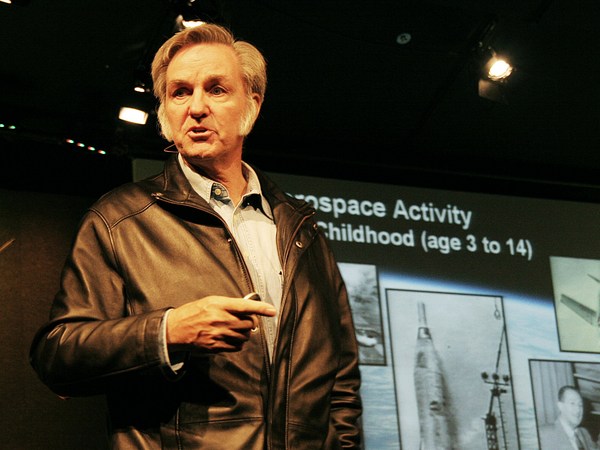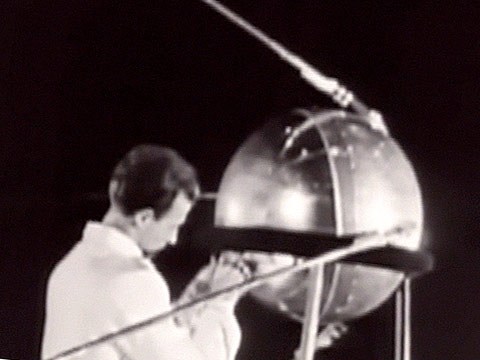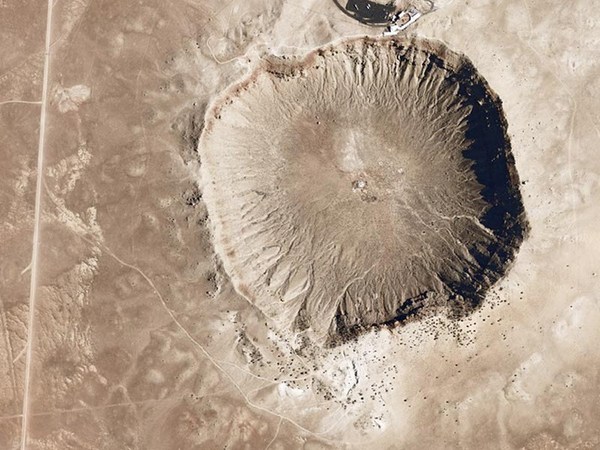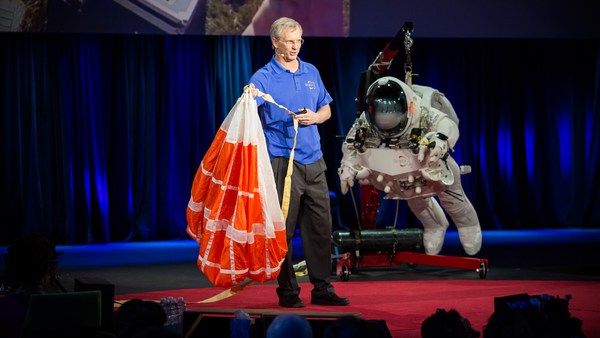I'm a historian. Steve told us about the future of little technology; I'm going to show you some of the past of big technology. This was a project to build a 4,000-ton nuclear bomb-propelled spaceship and go to Saturn and Jupiter. This took place in my childhood, 1957-65. It was deeply classified. I'm going to show you some stuff that not only has not been declassified, but has now been reclassified.
(Laughter)
If all goes well, next year I'll be back, and I'll have a lot more to show you, and if all doesn't go well, I'll be in jail, like Wen Ho Lee.
(Laughter)
So, this ship was basically the size of the Marriott Hotel, a little taller and a little bigger. And one of the people who worked on it at the beginning was my father, Freeman, there in the middle. That's me and my sister, Esther, who's a frequent TEDster. I didn't like nuclear bomb-propelled spaceships. I mean, I thought it was a great idea, but I started building kayaks. So we had a few kayaks. Just so you know that I am not Dr. Strangelove.
But all the time I was out there doing these strange kayak voyages in odd, beautiful parts of this planet, I always thought in the back of my mind about Project Orion, and how my father and his friends were going to build these big ships. They were actually going to go -- Ted Taylor, who led the project, was going to take his children. My father was not going to take his children, that was one of the reasons we sort of had a falling out for a few years.
(Laughter)
The project began in '57 at General Atomics there, that's right on the coast at La Jolla. Look at that central building right in the middle of the picture. That's the 130-foot diameter library. That is exactly the size of the base of the spaceship. So put that library at the bottom of that ship -- that's how big the thing was going to be. It would take two or three thousand bombs. The people who worked on it were a lot of the Los Alamos people who had done the hydrogen bomb work. It was the first project funded by ARPA. That's the contract where ARPA gave the first million dollars to get this thing started. "Spaceship project officially begun. Job waiting for you. Dyson." That's July '58. Two days later, the space traveler's manifesto explaining why -- just like we heard yesterday -- why we need to go into space: "... trips to satellites of the outer planets. August 20, 1958."
These are the statistics of what would be the good places to go and stop. Some of the sizes of the ships, ranging all the way up to ship mass of 8 million tons. So that was the outer extreme. Here was version two: 2,000 bombs. These are five-kiloton yield bombs, about the size of small Volkswagens; it would take 800 to get into orbit. Here we see a 10,000-ton ship will deliver 1,300 tons to Saturn and back -- essentially, a five-year trip. Possible departure dates: October 1960 to February 1967. These are trajectories going to Mars. All this was done by hand, with slide rules. The little Orion ship, and what it would take to do what Orion does with chemicals: you have a ship the size of the Empire State Building.
NASA had no interest; they tried to kill the project. The people who supported it were the Air Force, which meant that it was all secret. And that's why when you get something declassified, that's what it looks like. Military weapon versions that carried hydrogen bombs that could destroy half the planet. There's another version there that sends retaliatory strikes at the Soviet Union. This is the really secret stuff: how to get directed energy explosions. So you're sending the energy of a nuclear explosion -- not like just a stick of dynamite, but you're directing it at the ship. And this is still a very active subject. It's quite dangerous, but I believe it's better to have dangerous things in the open than think you're going to keep them secret.
This is what happened at 600 microseconds. The Air Force started to build smaller models and actually started doing this. The guys in La Jolla said, "We've got to get started now." They built a high-explosive propelled model. These are stills from film footage that was saved by someone who was supposed to destroy it but didn't, and kept it in their basement for the last 40 years. So, these are three-pound charges of C4; that's about 10 times what the guy had in his shoes.
(Laughter)
This is Ed Day putting -- So each of these coffee cans has three pounds of C4 in it. They're building a system that ejects these at quarter-second intervals. That's my dad in the sport coat there, holding the briefcase. So, they had a lot of fun doing this. But no children were allowed; my dad could tell me he was building a spaceship and going to go to Saturn, but he could not say anything more about it.
So all my life I have wanted to find this stuff out, and spent the last four years tracking these old guys down. These are stills from the video. Jeff Bezos kindly, yesterday, said he'll put this video up on the Amazon site -- some little clip of it.
(Applause)
So, thanks to him. They got quite serious about the engineering of this. The size of that mass, for us, is really large technology in a way we're never going to go back to. If you saw the 1959 -- this is what it would feel like in the passenger compartment; that's acceleration profile.
(Laughter)
And pulse-system yield: we're looking at 20-kiloton yield for an effective thrust of 10 million newtons. Well, here we have a little problem, the radiation doses at the crew station: 700 rads per shot.
(Laughter)
Fission yields during development: they were hoping to get clean bombs; they didn't. Eyeburn: this is what happens to the people in Miami who are looking up.
(Laughter)
Personnel compartment noise: that's not too bad; it's very low frequencies, it's basically like these sub-woofers. And now we have ground-hazard assessments when you have a blow-up on the pad. Finally, at the very end in 1964, NASA steps in and says, "OK, we'll support a feasibility study for a small version that could be launched with Saturn Vs in sections and pieced together."
So this is what NASA did, getting an eight-man version that would go to Mars. They liked it because the guys could kind of live there and be like, "It's like living in a submarine." This is crew compartment. It switches, so what's upside down is right side up when you go to artificial gravity mode. The scientists were still going to go along; they would take seven astronauts and seven scientists. This is a 20-man version for going to Jupiter: bunks, storm cellars, exercise room. You know, it was going to be a nice, long trip.
The Air Force version: here we have a military version. This is the kind of stuff that's not been declassified, just that people managed to sneak home and after, you know, on their deathbed, basically, gave me that. The sort of artist conceptions. These are basically PowerPoint presentations given to the Air Force 40 years ago. Look at the little guys there outside the vehicle. And one part of NASA was interested in it, but the headquarters in NASA, they killed the project. So finally, at the end, we can see the thing followed its sort of design path right up to 1965, and then all those paths came to a halt.
Results: none. This project is hereby terminated. So that's the end.
All I can say in closing is: we heard yesterday that one of the 10 bad things that could happen to us is an asteroid with our name on it. And one of the bad things that could happen to NASA is if that asteroid shows up with our name on it nine months out, and everybody says, "Well, what are we going to do?" And Orion is really one of the only, if not the only, off-the-shelf technologies that could do something.
(Laughter)
So I'm going to tell you the good news and the bad news. The good news is that NASA has a small, secret contingency-plan division that is looking at this, trying to keep knowledge of Orion preserved in the event of such a misfortune. Maybe keep a few little bombs of plutonium on the side. That's the good news. The bad news is, when I got in contact with these people to try and get some documents from them, they went crazy because I had all this stuff that they don't have, and NASA purchased 1,759 pages of this stuff from me. So that's the state we're at; it's not very good.
(Laughter)
(Applause)





